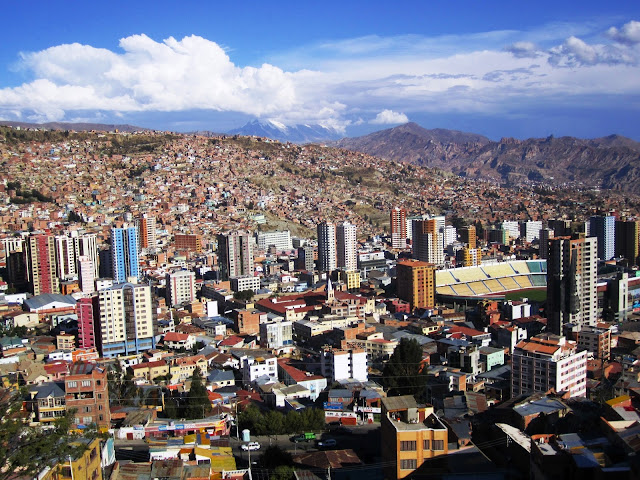On Monday
7 November I flew from Sucre to La Paz. At the airport I bumped into a
traveller I had talked to before – Sue from Beuly and her 4 friends had been at
the same hotel as me in Uyuni and were now also going to La Paz – so I had some
company while waiting for my flight. One of the highlights of travelling alone
is the people you meet along the way.
The
flight took just an hour and there were magnificent views of the Royal Andes
mountain range and La Paz, as we headed in to land. Tony the tour guide was
waiting for me and I was quickly whisked off to my hotel. I dumped my stuff,
then headed down the road for a chicken burger and chips for lunch. Delish!
Tony and
our driver returned at 2.30 and we started our exploration of this impressive
city. First was the Witches Market, a fascinating area of stalls selling aphrodisiac
formulas, a variety of the herbs used in popular remedies, soapstone figures
representing the different creatures important in the local culture (like frogs
for wealth and good fortune), and some of the bizarre ingredients used to
manipulate the spirits that populate the Aymara world. Most revolting were the dried
llama foetuses, which are buried in the foundations of new houses as an
offering to the earth goddess Pachamama to bring prosperity to the inhabitants.
I was told these are only used by the poor; the rich are expected to sacrifice
a live llama!
 |
| A basket of offerings to Pachamama, including a dried llama foetus! |
There
were also statuettes of little men, hung with paper money and festooned with
the various items desired by the owner, to be kept in business premises to bring
good luck. Apparently, the Catholic church has decided it is better to accept rather
than reject such pagan offerings, so the statuettes now get taken to church to
be blessed as well. Nothing like covering your bases!
We drove
on through the crazy traffic of the main street, then out through the suburbs,
past security-conscious embassy buildings, the official residence of the president,
and the headquarters of the Bolivian navy. I had to laugh at that one – Bolivia
is a landlocked country, except for 40% of Lake Titicaca, and Chile has denied
them access to the Pacific Ocean, so why have a navy?
As we descended
further down the valley, the temperature rose by 2 degrees to 26°C, and it was
greener and more lush, with palm trees and colourful flowering bougainvillea. Next
stop was the Valley of the Moon, with its strange rock formations caused by rain
eroding the clay soil. In fact, much of the land around La Paz looks similarly
unstable and subject to erosion, and Tony said there are frequent landslides in
the rainy season.
We drove
back towards the central city through posh suburbs with grand houses that could
have been anywhere in the world to the Killikilli lookout for another fabulous
view over the city – it is certainly a spectacular setting.
 |
| Just a small part of the huge city that is La Paz |
 |
| The National Guard |
 |
| La Paz's main plaza |
 |
| The Legislature building |
 |
| Calle Jaen |



I have been told there are perfectly valid reasons for Bolivia to have a navy so thanks to the person who enlightened me:
ReplyDelete"The reason why Bolivia has a navy is quite logical actually. The navy is in charge of controlling some of our borders: Titicaca lake is one of those. The navy also operates in the river Mamoré; the natural border between Brasil and Bolivia."